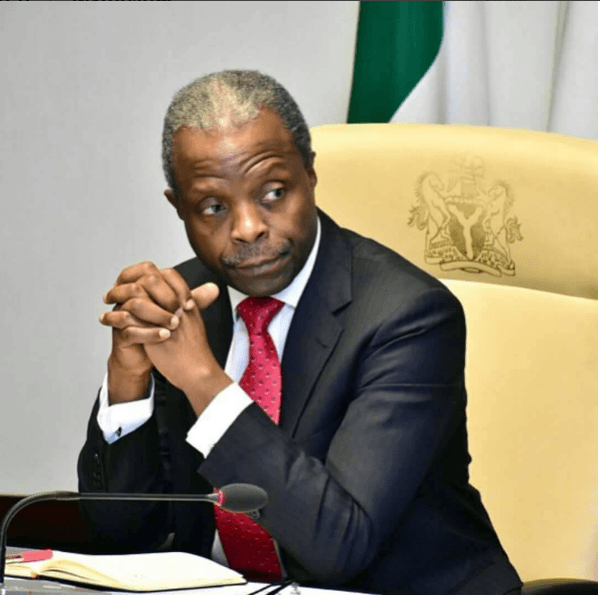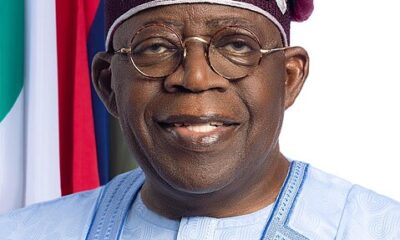Economic Issues
Mumu smiles back into debt trap -By Henry Boyo


Acting President Yemi Osinbajo
1st Man: I am disturbed by the rate at which the country is getting foreign loan.
2nd Man: Why?
1st Man: We’ve borrowed N7.1tn in just two years.
2nd Man: There’s no cause for alarm, my friend.
1st Man: Really? You think the loans will be judiciously used?
2nd Man: No, but at our age, that should be our least concern.
1st Man: Why?
2nd Man: That’s the burden of our children and children’s children.
The above narrative is culled from NEEARO’s “NO JOKE” cartoon strip in The PUNCH newspaper of June 6, 2017.
In October 2016, the Federal Government sought the National Assembly’s approval to borrow $29.96bn for infrastructural development from multilateral agencies. In March 2017, the Senate approved $500m from a proposed $1bn Eurobond, while in June 2017, Acting President Yemi Osinbajo presently seeks the National Assembly’s approval for a fresh $1.5bn loan!
Curiously, government has remained noticeably reticent and has never bothered to explain why these modest foreign loans are sought, while the Central Bank of Nigeria still hoards over $30bn idle reserves, which it regularly auctions in a naira surplus market and primitively allocates also to Bureau De Change operators.
However, in May 2017, the National Bureau of Statistics, reported that by December 31, 2016, the Federal Government and 36 states already owed about N18tn (i.e. $11.4bn foreign and N14.02tn domestic debts respectively, calculated at the invisible exchange rate of N360/$). According to the NBS report, foreign and domestic debts rose by 6.5 and 36 per cent respectively, between 2015 and 2016. In retrospect, during her visit to Nigeria, in January 2016, Christine Largarde, the IMF President, endorsed concerns consistently expressed in this column about government’s “ambitious” plan to dedicate 35 per cent of all generated revenue to servicing its existing debt.
Meanwhile, the Federal Government’s proposed 2017 borrowing plan of about N2tn is expected to push annual debt service charges well above 50 per cent of total generated revenue; thus, over N50 out of every N100 revenue may be dedicated to servicing debt this year. It is disturbing that almost 40 per cent of such loans, obtained with high interest rates between 13 and18 per cent will be simply spent on salaries and the usual daily operating expenses, including “welfare”.
Furthermore, a director of the IMF, Vitor Gaspar, on April 19, 2017, bemoaned, at an “IMF Fiscal Monitoring” briefing in Washington, that “66 per cent of Nigeria’s tax revenues are spent on servicing debts, and therefore called on the government to raise more taxes. (see www.thecable.ng).
Although some experts have glibly canvassed a strategy of “spending our way out of recession”, regrettably, these experts and their collaborators have never indicated where the funds for additional spending will come from. However, if government succumbs to this ill-considered persuasion, debt accretion will further accelerate, and debt service charges may eventually consume over three quarters of aggregate revenue, particularly, if government loans continue to attract almost 20 per cent interest rates, with the horrid collateral that the productive sector will remain aggressively crowded out from supportive, low cost loans that should stimulate productivity and increase employment.
Ironically, higher naira liquidity surpluses induced by any “strategic” increase in government spending, will definitely worsen the undeniable, already existing bloated, oppressive naira liquidity surfeit and therefore compel additional borrowing at atrocious rates of interest by the CBN to reduce the inflationary threat from the increased naira liquidity that is unleashed on the system by any expansion in government spending.
Nonetheless, the inevitable aggressive borrowings by the CBN to reduce the resultant liquidity excess and restrain spending and inflation will, inadvertently, further spike lending rates and compound the funding challenges of all sectors and also reduce any prospect of industrial expansion, job creation or economic diversification.
Although the Minister of Finance, Kemi Adeosun, and some experts seem enamoured by the lower interest rates, generally below seven per cent, for foreign loans as against the much higher, prevailing 12-18 per cent for the Federal Government’s domestic loans, we must however, approach foreign loans with utmost caution. For example, a $1bn loan at seven per cent would attract $70m interest or N7bn annually, if naira exchanged for N100=$1. However, the same $1bn loan would attract N21bn, if naira depreciates to say N300=$1. So, although foreign loans may be optically cheaper, unyielding naira depreciation, over time, would spike service and repayment cost oppressively and may ultimately precipitate another horrendous debt trap, particularly if the dollar exchange rate begins to be expressed in thousands of naira by the next generation. The present exchange rate of N306-400/$ would have been considered impossible, when naira was 50k to the dollar over 30 years ago.
This column has carried a series of commentaries on debt sustainability for several years. The following narratives are excerpts from “Budget 2010: Mugu smiles back into debt trap” see www.lesleba.com (April 2010). Please read on:
“While the controversial $30bn debt we exited in 2006 took well over a decade to accumulate, it required just over three years, by 2010 to accumulate a fresh debt burden of over $30bn.
The Director General of the Debt Management Office, (see www.lesleba.com) “Nigeria’s Debt creation Office” September 2009) in a PUNCH newspaper report of December 1, 2009, titled, “Debt servicing to gulp N517bn in 2010”, confirmed that total domestic debt as of October 2009 was about N2.5tn, if the N1,500bn projected deficit in the 2010 Appropriation Bill is excluded. The 2009 budget had allocated N283bn (eight per cent) for debt service, but this provision has almost doubled to N517bn in the 2010 appropriation bill. Consequently, if the 2010 deficit is financed through borrowing, our total domestic debt will approach N4000bn (i.e. N2,500bn plus N1,500bn) or over $27bn at N150=$1.
Thus, the consolidated sum for domestic and external debt would exceed $30bn ($27bn + $3.7bn)! Sadly, after the exit from the controversial debt relief that cost Nigeria over $18bn only three years ago, it is déjà vu. Evidently, the billions of dollars paid to exit the debt trap have added no tangible social or economic value. It is worrisome that the main beneficiaries of the juicy rates of return on government’s humongous annual domestic borrowings are the same sectoral group to whom the Central Bank of Nigeria, recently, generously endowed with more than N600bn in bailout packages after they messed up! The cost of servicing the existing external debt of $3.7bn with N38.92bn, i.e. about six per cent is also untenable, if indeed these are predominantly, according to government, multilateral debts obtained with concessionary, low interest rates, usually between one and two per cent.
Nonetheless, why borrow so expensively when, in fact, surplus naira persists and the CBN continues to hoard relatively healthy reserves, estimated at over $44bn in the 2010 budget. It is equally worrisome that most of these debts were accumulated as a result of government’s mismanagement of its monetary strategies rather than the product of resourceful application of these loans for social welfare and infrastructural enhancement.
Instructively, the DMO’s bond issues at inception were targeted at intangible and questionable benefits such as deepening the market for bonds and setting a rate benchmark for long term borrowing at a time when government’s domestic debt was less than N1tn with about $3bn also as external debt. The National Assembly may not be relied upon to restrain further debt accumulation to avoid a fresh debt trap as this would constrain their tradition and capacity for frivolous expenditure.
In conclusion, I will reiterate that the adoption of dollar certificates for payment of dollar denominated revenue, as monthly allocations to the constitutional beneficiaries, will rescue us from this tragic debt trap, and spur our economy into rapid recovery mode with the appropriate enabling environment of single digit inflation and interest rates that will stimulate industrial expansion and increase employment and restrain further debt accretion.”


















